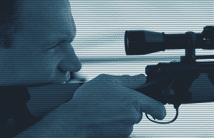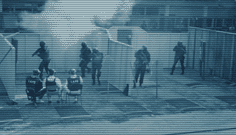A Day in the Life
 Training
Training
SWAT officers spend about 40 percent of their time in training activities. The first four days of SWAT's one-month deployment periods are spent in practicing weapons tactics. This training is split between live-fire accuracy drills and movement training. Other skills, such as climbing and rapelling, occur on a more flexible basis.
Specialized skills training occurs within seven officer-staffed cadres: sniper, shooting, climbing/rapelling, negotiations (CNT), self-defense, breachers, and emergency medical technicians (EMT). Each cadre is comprised of officers who receive special training and cross train the remainder of the platoon in that skill. The only cadre that does not cross train the remainder of the platoon are the snipers. Cadres will often cross-train with other special tactics groups to hone particular skills.
Patrol and Call-Ups

After a daily strength and aerobic workout session, SWAT members will receive their daily briefing. SWAT members are usually dispatched as two person teams to high-crime areas to assist law enforcement activities. "This we call 'crime supression,'" says SWAT officer Lou Villalobos. "We have our SWAT equipment with us so if we do have some type of barricade or hostage situation, we'll respond to it immediately, anywhere in the city."

SWAT responds to the following types of missions: VIP protection, hostage rescues, barricaded suspects, high-risk warrant service, and rapid deployment situations. SWAT can expect to respond to about 150 incidents each year.
City-issued black-and-white take-home police vehicles are provided to each team of officers and each supervisor. Each officer's equipment and other logistics are stored in the vehicles. Additional equipment is secured in the SWAT truck that's driven to the scene of each tactical incident.



